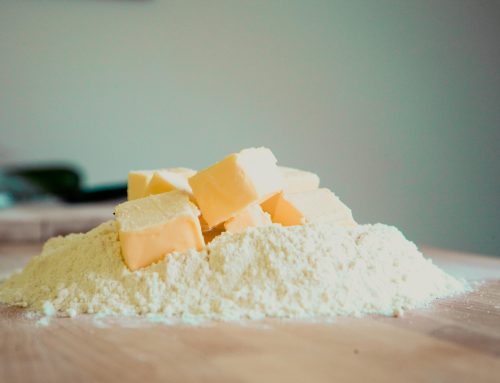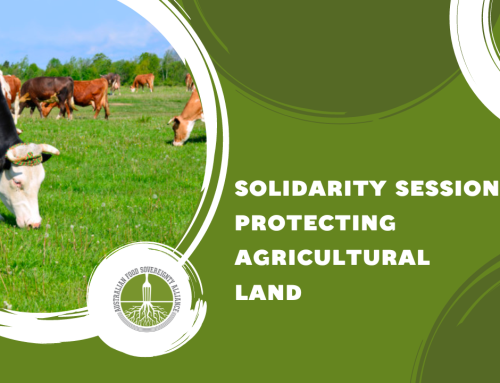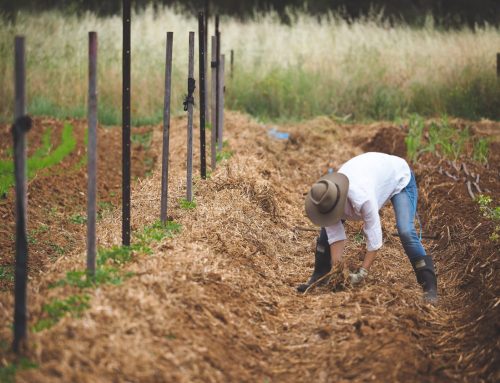… story by Russ Grayson, 8 December 2013
It was a city already saturated from days of rain that those of us peering through the big windows of Blacktown Council’s Narimba room looked out over. A grey scene of low clouds scudding past, their dark mass frequently unleashing the downpours that have become a constant presence in city life this past week, the clouds and showers hid, then revealed, an urbanised landscape of sprawling proportions. It was when someone identified the tops of highrise buildings on the horizon as being in Parramatta that we got a hint of the scale of this region.
This is a region, said Clarissa Davis — environmental engagement officer with Blacktown Council — that will see a population increase of an additional 200,000 people within 20 years. It is the work of Clarissa and her council colleagues to ensure that those people enjoy a food secure future that offers more than pink soup.
Pink soup, the children call it. Yes, it sounds suspicious and it is, nutritionally. Pink soup is food (if that is the word), part of the diet of some families out here. And this pink soup the children are given? It’s the water that the family’s dinner of hot dog sausages has been cooked in. It’s their meal and it is an example of something that those working in food security and community development hear time after time — that a lot of people don’t know how to buy and cook food. Ofter, those people struggle financially, making pink soup a function of poverty.
DIMINISHING THE CULINARY DIVIDE
Not so long ago journalists, technology watchers and social workers used to talk about the digital divide. That was about access to computers and the knowledge of how to make good use of them. Now, we can talk about the culinary divide — access to good food and the knowledge of how to prepare it. Diminishing that divide is a task of health and nutrition promoters, food advocates and, increasingly, local government.
Food security is about what families eat and how affordable it is. Add to those factors I mention above the question of how and where they obtain their food and you start to talk about food sovereignty, about freedom of choice in the foods families eat. Those who work to improve food security and food sovereignty — the latter includes the livelihoods of small to medium scale farmers, food processors and smaller retailers that bring it to us — know that all is not well.
Food insecure people, especially those struggling financially, buy the cheapest food at the supermarket. And that’s something you can’t fault them for.
Now, thankfully, the more innovative councils with a genuine interest in the wellbeing of their citizens are starting to do something about our food future. For Clarissa and her colleagues it was the theme of the one-day seminar hosted by Blacktown Council under the title, Securing Our Food Future.
ALREADY, A GOOD START
Blacktown Council has made a good start aided in no small way by Clarissa’s background in permaculture design (permaculture is a design approach to sustainable living and community development). She explained how council offers workshops in sustainable living, assists the development of community food gardens where people can grow some of what they eat (council has developed a policy to enable support to community gardens), a grant scheme for school food gardens, visits to farmers’ markets, food-related video screenings, a farm gate tour and, very successfully, a workshop in pasta and bread making that brought both culinary and social benefits and the opportunity to talk about the values of food.
Other councils, and not just those in Sydney’s west, offer similar educational opportunities. The fact that councils are doing this shows how community expectations and social needs have changed since the days when local government dealt in only the three R’s — rates, roads and rubbish. That seems so long ago, in another, distant era of local government in Australia.
The fact that Blacktown invited people from community organisations to the seminar highlights the realisation in progressive councils that civil society and its organisations are critical to securing a nutritious food future. Those at Securing Our Food Future included a group from Permaculture Sydney West including their make-it-happen organiser, Greg Mayer. There were academics too, from Sydney University and University of Western Sydney, and people from food advocacy and education organisations like health educator Liz Millen from Sydney Food Fairness Alliance and myself from the Australian Food Sovereignty Alliance. Ian Sinclair from Edge Land Planning, probably one of the most knowledgable people when it comes to the urban/rural fringe, brought his decades of expertise.
A hopeful sign were those from state government departments and quangos such as the Hawkesbury-Nepean Catchment Management Authority, NSW EPA, NSW Health, Northern Sydney Health Promotion and the Premier’s Council for Active Living. As well as Blacktown Council, Camden, Randwick, Canada Bay, City of Sydney, Hornsby, Mosman, Holroyd, Marrickville, North Sydney, Penrith, Parramatta and Willoughby were all represented.
This spread of attendees surely indicates that there’s a firm nexus linking local government and our food future.
INTERVENTION
It was this nexus that was the core holding together the projects and work of those attending.
According to Regional Development Australia Northern Rivers Claire McGarry, local government has five main avenues of intervention in regional food systems — community education, governance and leadership including initiatives such as sustainable catering in councils, research, fostering partnerships and planning and infrastructure. This latter intervention includes reviewing planning and other policy to ease the work of increasing food security and food sovereignty.
Some councils have already made moves in this direction by adopting policy for council catering and for the development of community food gardens. A few, such as City of Melbourne, have adopted progressive food policies. Now, an increasing bevy of councils are offering community education in the form of workshops and courses in a broad range of food-related areas such as bread making and organic gardening and other skills and, in some instances such as Randwick Council’s Barrett House community centre, making available space for community food systems like Rhubarb Food Co-op to distribute their foods to members.
FOOD WITH A HUMAN FACE
Following her fellowship-enabled research tour of the US and other places, Jane Adams returned to Australiaand more or less invented the farmers’ market component of the food chain.
A woman somewhere around middle age with a mop of blonde hair and a firm voice, Jane described her journey into the farmers’ market sector and explained the needs and values of the markets.
“At farmers’ markets we find food with a human face and a sense of place”, said Jane.
There must be no resellers of fresh foods, she said, if they are to be authentic farmers’ markets. Resellers buy produce at the wholesale markets or elsewhere and offer it at farmers’ markets. That makes them no different to a shop. While a later speaker said that the markets he is associated with allow resellers so as to broaden offerings — they are identified as such just as authentic growers are clearly identified — Jane was adamant that resellers diminish the credibility of farmers’ markets and reduce their authenticity.
“Authenticity is a success factors for farmers’ markets. They have to be the real deal, places people go mainly for food”, she said.
Markets, said Jane:
- must have a food focus to distinguish them from other types of community markets — “People have got to go to the market especially to buy food… fresh, healthy, seasonal food”, said Jane
- stands staffed by the farming family or farm staff
- fresh, healthy food only from the farm or community garden
- opportunity for buyers to meet the farmer
- and value-added products made mainly from foods produced on the farm.
“Other success factors in addition to the authenticity of a genuine place where farmers sell what they produce include a diversity of high quality food products; mostly fresh food; a regularity of operation such as weekly; an all-weather, focal point site; professional management other than by a stallholder and including a vendor committee; local government support; and inclusion in networks.
“Farmers’ markets should build networks with food buyers, cafes and chefs, food service buyers, organic food groups and food co-ops, regulators, hotels, school and community gardens that can have stalls and food retailers”.
TOURISM SERVING FARMERS
According to Hawkesbury Harvest’s Ian Knowd, tourism — food tourism —offered the solution to creating Hawkesbury Harvest’s Farm Gate Trail by sidestepping regulations that had prevented farm sales of food.
“If we want a secure food future we need secure farmers. Hawkesbury Harvest is about farmers. It is about tourism working for farmers, not farmers working for tourism. It is also about the people who buy and eat the farmers’ food”. This he disclosed when he said the oranisation does not refer to buyers by the dry, impersonal economist’s term of ‘consumers’. It calls its farm customers ‘eaters’.
As well as the Farm Gate Trail, Hawkesbury Harvest runs a number of farmers’ markets and a program for schools called Paddock To Plate, in which a total of 14 schools currently participate.
Hawkesbury Harvest’s focus on Sydney region farmers was reiterated by Strategy Audit’s Allen Roberts, a man with years in the food industry who is currently associated with Regional Development Australia.
Allen described the decline of Australia’s food industries, saying that 25 percent of our food is now imported. Of the $26.5 billion worth of imported food, $2.2 billion more goes on imports than we earn in exports, a figure on the increase.
“The $111 billion value of Australia’s food industry supports 26,500 businesses according the the Australian Bureau of Statistics, of which 1350 are food manufacturing businesses, down from 10 to 15 years ago”, he said.
“Retail consolidation is a trend affecting the Australian food industry. Woolworths and Coles control 75 percent of the retail grocery market, double the overseas average of around 23 percent.
“Other trends include farm consolidation. The family farm is fighting for its life. Driven by the supermarket push to keep down food prices, this leads to monocultures. Local farmers can’t compete on prices and this is destroying the small farm sector.
“At the same time there’s a counter trend of small retailers occupying the cracks in the supermarket system. Greengrocers, although they have declined in number, are good at what they do and continue to exist. Small, specialist growers such as those growing for the organic market serve specialised parts of the food market. Consumers are redefining value by buying food with fewer chemicals applied to it and buying on other factors”.
Urbanisation can be managed to include agriculture, Allen said. “At the moment, land is worth more for urban development than for farming and we need to address this. Leveraging consumer value provides farmers with the opportunity to respond”. Farmers’ markets, said Allen, are a way to do this and to outflank the big food retailers.
Allen, working with Regional Development Australia’s Sydney Food Initiative, is trialing Sydney Harvest, a scheme linking, initially, a small number of food retailers with farmers and associated logistics. The intention is to connect farmers close to the city with eaters in the city.
According to Allen, people moving to the urban fringe where the city meets the countryside are a big part of the problem affecting the viability of farms. Using the pollution laws that are written for urban areas rather than for farming, complaints to councils about the noise, odour and hours of operation of farming leads to limitations being placed on farmers. He believes we need zones set aside for farming in which regulation favours farming operations, and we need to amend the pollution laws so they stop being discriminatory against farmers.
LESS RESEARCH, MORE ACTION
In addressing food security and developing a viable, regional farming economy, Allen said organisations need to stop sinking funds into more research. He said we already have enough research and that applying funds to actually doing something with it is the pressing need.
Something similar was said in conversation by a local government staffer with long experience in community education and council projects. She said that much grant funding is expended on more and more trial projects designed to assess an idea or gather data but then, when the grant and the project end, nothing happens with the information and the experience of the project.
What’s needed, she said in reiterating Allen’s sentiment, are fewer trials and more implementation of what we already know — making and doing rather than continually studying things, that is. It’s a call for less paralysis by analysis and more making things happen.
“Councils are in a great position to assist urban fringe farmers and citizens because they are close to their communities”, Allen said. “They need to think beyond the election cycle and not tell us stuff we already know as that affects their credibility. They need to find and focus on what’s important and apply resources”.
RESOURCE KIT WILL OFFER GUIDELINES
After a more-than-plentiful lunch supplied by a local social enterprise, the Fairfield High School Parents’ Cafe, the rest of the day was taken up in group discussions around planning, farmers’ markets, education and community food production in the city.
The good news for local government seeking to intervene in the food security of their citizens and to support their food sovereignty will be the resource kit being developed by Claire McGarry and her colleagues at Regional Development Australia Northern Rivers.
With a focus on urban agriculture among other things the resource, according to Claire, will serve as a guide for councils, ensuring they don’t have to reinvent what other councils and organisations have already invented.
TO BOLDLY GO
Thinking about the Securing Our Food Future seminar, it occurs to me that this wouldn’t have happened a decade ago. Food security and food sovereignty were not even visible on local government’s distant horizon then. Ten years can make a lot of difference.
To paraphrase a well-known quote, councils are now boldly going where no council has gone before… into the realm of boosting their communities’ food security and ensuring that those communities have the freedom of choice over the foods they eat and the opportunity to obtain them from those producing, processing and distributing them in ways they wish to support. This, surely, is the basis if any authentic market economy.
It’s still early days, this move of councils and citizens towards food sovereignty, but what was encouraging were the number of councils represented at Securing Our Food Future. It is said — and it’s a truism, I believe — that citizens lead and government follows. I think this is as it should be for we’ve seen far too many bad examples of government attempting to lead. I would like to amend this when it comes to our food sovereignty, though, and suggest that councils and citizens work out ways to form creative partnerships and so share the work of leadership.
This will be no simple task. Citizens will need to learn to have patience as will council staff who will also benefit by enlisting citizen support to amend overly-restrictive policy and regulatory barriers to securing regional food futures and building economically and environmentally viable regional food economies.
There is much to do. Securing Our Food Future, by bringing together a diversity of interests in urban food systems, was a positive step on the road that takes forward-thinking councils and their citizens boldly where none have gone before.
……
Securing Our Food Future was hosted by Blacktown City Council with support from Regional Development Australia and NSW Environmental Trust funding.





